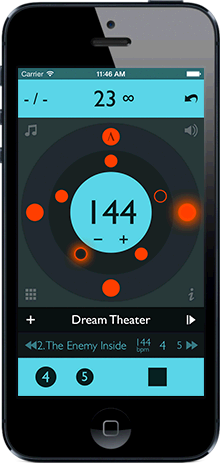5-Minute Read: Metronome Games!
No sound is as dreaded by director and performer alike as the piercing click of a metronome. We're all ambivalent about the humble metronome; we love it for its contributions to a solid performance, but we hate the frustrating process of playing to an immovable, uncompromising pulse. But there are some techniques and processes that we can employ with the metronome to both help our bands, and make the metronome a little less misery-inducing. Please note that the following notes can be complicated by asymmetrical and/or mixed meters, so use your best judgement for the musical passages that apply in your own show.
"Subdivide, subdivide, subdivide!"
Most of us have have had this mantra preached at us, and then we've preached it to our own ensembles. And it's true! Student performers must learn to subdivide for rhythmic accuracy, maintenance of pulse, and to properly execute marching fundamentals. However, simply turning on the metronome, with 8th note subdivisions banging away, may not be the most effective way to get your group to internally subdivide. For one thing, if the metronome is subdividing for them, they don't have to. True, the ensemble must fit their performance into the regular pulse the machine provides, but it's doing the work. Therefore try this technique in music and field rehearsals. Let's assume you're playing a chart in 4/4 at MM=148
- Start by setting the metronome to double the metronome marking, in this case MM=296. Yes, you could simply turn on the 8th-note subdivider if your metronome has that function. Rehearse to that tempo to find areas where rhythmic and pulse imprecision occur.
- Once you know the areas that need to be firmed up metrically, set the metronome to the marked tempo (MM=148).
- Now we begin making the students really do the subdivision themselves. Set your metronome to half the marked tempo, or every 1st and 3rd beat (MM=74). Now the performers have to provide the internal subdivision themselves to ensure they arrive at the major downbeats as an ensemble. This also works well because the marching performers will have their left foot lining up with each metronome click.
- Finally, provide the ensemble with only first downbeat of each measure by setting the metronome to 1/4th of the marked tempo (MM=37).
Using this method can truly improve the subdivision skills in your ensemble members.
Empower your Field Conductor
The technique of placing an audible metronome at the back of the ensemble is sound and effective. It allows the ensemble to listen to the back so that the audience hears a unified sound beyond the sidelines. However, sometimes it can encourage so much listening that students come to rely on what they hear and cease watching the field conductor or drum major. So mix it up a bit by giving only your conductor the metronome!
Once you've solidified your field show enough, try putting some good earphones over your drum major's ears and connecting them to a metronome. Now, only your drum major has the audible pulse, and the band is forced to completely trust their hands.
Want to up the ante even more with this technique? Ear plugs. They're cheap (check out this box of 200 pairs at less than $20 on Amazon) and very handy, especially if you're preparing your band for an indoor performance where echoes and acoustic concerns impede listening across the field. Regardless of venue, placing a metronome on your drum major's ears and forcing your band to only march to their conducting hands can really dial in your ensemble and take your performance to the next level!



